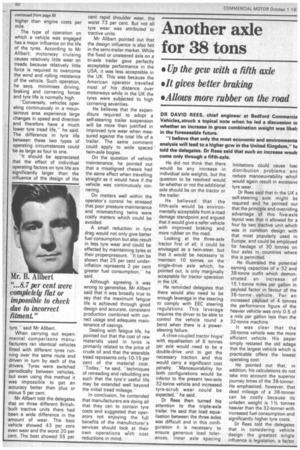Another axle for 38 tons
Page 92

Page 93

If you've noticed an error in this article please click here to report it so we can fix it.
DR DAVID REES, chief engineer at Bedford Commercia Vehicles,struck a topical note when he led a discussion or whether an increase in gross combination weight was like!) in the foreseeable future.
"I believe that only the most economic and environmenta analysis will lead to a higher gcw in the United Kingdom," fic told the delegates. Dr Rees said that such an increase woulc come only through a fifth-axle.
He did not think that there would be any increase in individual axle weights, but the question to be resolved would be whether or not the additional axle should be on the tractor or the trailer.
He believed that the fifth-axle would be environmentally acceptable from a road damage standpoint and argued that it would give a safer vehicle with improved braking and more rubber on the road.
Looking at the three-axle tractor first of all, it could be envisaged as a twin-steer, but that it would be necessary to maintain 10 tonnes on the single-drive axle which, he pointed out, is only marginally acceptable for tractor operation in the UK. .
He reminded delegates that there would also need to be enough leverage in the steering to comply with EEC steering regulations. This leverage requires the driver to be able to control the vehicle round a bend when there is a powersteering failure.
A close-coupled tractor bogie" with equalisation of 8 tonnes per axle would need to be a double-drive unit to get the necessary traction and this would carry a significant cost penalty. "Manoeuvrability for both configurations would be inferior to the present two-axle 32-tonne vehicle and increased tyre-scrub wear could be expected," he said.
Dr Rees then turned his attention to the triple-axle trailer. He said that load equalisation between the three axles was difficult and in this configuration it is necessary to ensure generous load tolerances. Inner axle spacing lirnitations could cause loac distribution problems anc reduce manoeuvrability which would again result in excessive tyre wear.
Dr Rees said that in the UK a self-steering axle might be required and he pointed out that the principle and overriding advantage of this five-axle layout was that it allowed for a four by two tractive unit which was in common design with that most popularly used in Europe, and could be employed for haulage of 30 tonnes on four axles in countries where this is permitted.
He illustrated the potential earning capacities of a 32 and 38-tonne outfit which demonstrated an increase of 15.1-tonne miles per gallon in payload factor in favour of the 38-tonne vehicle. For an increased payload of 4 tonnes the performance figure of the heavier vehicle was only 0.5 of a mile per gallon less than the 32-tonne machine.
It was clear that the 38-tonne vehicle was the more efficient vehicle. His paper simply restated the old adage that the largest vehicle which is practicable offers the lowest operating cost.
He pointed out that, in addition, his calculations do not take into account the superior journey times of the 38-tonner. He emphasized, however, that dead mileage of a 38-tonner can be costly because its unladen weight is 11/2 tonnes heavier than the 32-boner with increased fuel consumption and significantly higher tyre costs.
Dr Rees told the delegates that in considering vehicle design the greatest single influence is legislation, a factor which tends to bring designs from different manufacturers closer together.
Future legislation contemplated for the UK market fell into a number of different categories. They were concerned with driver safety, the environment and primary safety and could be further identified with specific items such as cab impact, seat belts and anchorages, interior fittings, control location and arrangement, door latches and hinges, diesel emission. noise, road spray, exterior projections, weights and dimensions, anti-lock braking, headlamp levelling and rear under-ride protection.
We were all concerned as individual members of the public to see that the quality of life and the amenities were not jeopardised by uncontrolled technical evolution, The manufacturing industry was involved at the design stage in developing vehicles which would meet the proposed more stringent EEC noise legislation_ He warned that the ultimate benefits and costs in both money and materials must be determined and clearly understood.
One of the prime dilemmas facing the vehicle designer of top-weight vehicles was the question of whether or not there would be a continuing need for a specifically designed 32-tonner. It took at least four years to produce an all-new truck range — "that can be a long time in terms of changing trends in the market place and changing legislation.
"When we made the decision to proceed with the Bedford TM range we projected that there would be no nearterm uprating of the 32-tonne vehicle in the UK and that there would be a continuing need for a specifically designed 32-tonner after any increase in the UK maximum gcw."
This had meant that Bedford had designed and built two TM models, a 32-tonner for the domestic market and a 38-tonner for the EEC. T( minimise production and deve lopment costs Bedford an presumably other manu facturers with the same dilem ma had set out to rationalis their models without comprc mising the specific requirE ments of the operator on eithe model.
While it might be econom cally sensible to develop on vehicle for one market, Dr Ree emphasized that there are sti many considerations to ove come before this can b achieved. "In the event i higher UK gcw, and quite apa from any possible new fE structure effects, the operatiol .al advantages of higher gc within the UK will need to t carefully re-assessed if mo axles are added.




































































































































































